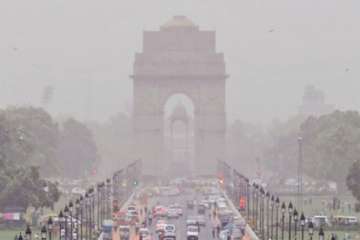Delhi fumes as air quality deteriorates to 'very poor' category, races towards 'severe' section
The overall Air Quality Index (AQI) of Delhi was recorded at 315 Wednesday, according to the Centre-run System of Air Quality Forecasting and Research.

Delhi's air quality on Wednesday deteriorated to 'very poor' category with several areas in the national capital nearing severe levels of pollution.
Stating that a number of factors were responsible for the deteriorating air quality, including vehicular pollution, construction activities and meteorological factors, the Central Pollution Control Board (CPCB) predicted further deterioration of the air quality in Delhi-NCR in the coming days.
Delhi's Environment Minister Imran Hussain said latest satellite images showed crop residue burning at "dangerous" levels and asserted that it should be stopped immediately or the entire north India, including Delhi, would suffer serious health hazards.
The Supreme Court-empowered Environment Pollution (Prevention and Control) Authority (EPCA) has already imposed since Monday the Graded Response Action Plan (GRAP), which prescribes a set of measures to curb air pollution, after Delhi's air quality deteriorated to "poor" a few days back.
A senior EPCA official said they were mulling implementing stringent measures like banning generator sets in the National Capital Region (NCR), increasing the parking fees and strengthening the public transport system in the coming days.
"We have already enforced measures for very poor air quality, but further stringent measures will be decided shortly," he said.
The overall Air Quality Index (AQI) of Delhi was recorded at 315 on Wednesday, according to the Centre-run System of Air Quality Forecasting and Research.
An AQI between 0 and 50 is considered "good", 51 and 100 "satisfactory", 101 and 200 "moderate", 201 and 300 "poor", 301 and 400 "very poor" and 401 and 500 "severe".
On Wednesday, Anand Vihar recorded an AQI of 358, Dwarka Sector 8 376, ITO 295, Jahangirpuri 333 and Rohini 330, according to the CPCB.
The PM10 level (presence in the air of particles with a diameter of less than 10 micrometres) in Delhi stood at 296 and the PM2.5 level was recorded at 139, according to the CPCB data.
This is the first time this season the air quality has deteriorated to the "very poor" category.
Further deterioration of the air quality has been forecast in the coming days with the PM10 level reaching 341 and the PM2.5 level 159.
A CPCB official said among the meteorological factors behind the falling air quality, the main reason was the drop and change of wind speed, which was now flowing from the stubble-burning areas.
He said on-ground implementation of the GRAP directions was being enforced, but the activities causing pollution were still continuing.
The GRAP is generally implemented if "very poor" or "severe" air pollution levels are recorded for 48 hours, but given the extent of winter pollution witnessed by the national capital, the plan was implemented as the air quality slipped to the "poor" category, the official said.
In addition, the CPCB has deployed 41 teams to monitor the implementation of the measures taken to combat air pollution.
In Delhi, Mr Hussain released the latest NASA image of north India and asked the people in the national capital to minimise local pollution, while noting that there will be "zero tolerance" for garbage and crop residue burning.
He also asked people to keep all construction material covered to stop dust re-suspension.
"It is high time crop residue burning in the fields must immediately be halted, failing which a serious health hazard awaits the entire northern India.
"It is beyond any reasonable understanding as to why this menace is being ignored, despite a well-known fact that the consequences will be disastrous in the coming days," the minister said in a statement.
Dust from unpaved roads, construction activities and traffic congestion are some of the main local factors causing the air quality of Delhi-NCR to deteriorate, as reported by 41 inspection teams deployed to monitor the implementation of the norms enforced to combat pollution.
According to the reports of the 96 CPCB inspections conducted till October 7, 554 violations were recorded.
The reports also listed the steps taken by the CPCB to deal with the violations, including informing the authorities like the Delhi Pollution Control Committee, the Municipal Corporation of Delhi and the New Delhi Municipal Council to impose suitable penalties.